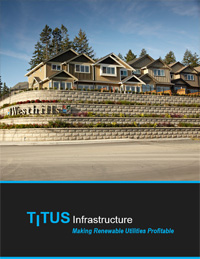By Leah Kellar
Energy efficient, environmentally friendly, and sustainable solutions for businesses are becoming ever more in demand these days. Accordingly, the innovation behind a pre-packaged approach to providing companies and communities with renewable, cost-efficient and profitable utilities is also high in demand. Enter TITUS Infrastructure Services Limited— an international renewable utilities service company that finances eco-friendly projects and oversees developing sustainable utilities with investment partners that truly understand the importance of having a profitable renewable utility in their community or development as fast as possible, and as cost effectively as possible.“TITUSInfrastructure Services was developed to commercialize a turnkey approach to making renewable utilities profitable, with the presupposition that if the utility is not profitable it will always be asking for subsidies or asking the utility regulator to raise the rates, both of which is negative for the taxpayer,” said company president, Erik Lindquist.
The firm provides a platform for building turnkey renewable utilities including a form of “eco-finance” with development partners, whether they are utilities, municipalities or developers.“In our model, the development partners put up 20 per cent equity, we give them 50 per cent of the ongoing net profits of the utility, and that’s really to ensure that our development partners have skin in the game and short cuts aren’t made so that everybody wins in that situation,” explains Lindquist. “Alternatively our development partners would have had to put up a higher per cent of equity or provide collateral that matches the cost of the utility as security if they’re going to bring on another utility partner. If they’re simply trying to build it up themselves as a utility, they will typically need 40 per cent equity.”
Lindquist had extensiveexperience in nuclear engineering and business restructuring for companies when he was first presented with the unique challenge of developing sustainable, profitable, and renewable utilities approximately nine years ago. The developer of Westhills (a large scale development project in B.C., currently with more than 350 single family homes connected to arguably the most advanced heating and cooling system in the world) asked Lindquist how he might help him to restructure a 6,000-unit development with 6-million square feet of commercial mixed-use and make it profitable. Lindquist set his mind to the task and developed a number of innovations that reduced energy supply requirements in a profitable and sustainable way by more than 50 per cent, and water supply requirements by more than 40 per cent.
“Many of these innovations were driven from a financial model that demanded we find ways minimize energy and water consumption where and when it was being used, to reuse energy and water, and only provide what is required, when it is required at the quality it is required, anything more is wasteful, and waste costs money. By applying these principles, we arrived at an integrated district energy and water sharing system with the potential to reduce energy and water consumption by more than 50%, the TITUS District Energy Sharing System (DESS).”
“From a business standpoint it just makes economic sense to do that. The reason that is important is because communities have already spent money in energy and water, and by recovering that energy and water within the community we can reduce the capital costs, the operating costs and make the utilities more profitableand provide a sustainable utility rate for the consumers, which is really our #1 objective. This way we create a win/win opportunity for everyone. And if we can do that, we’ll be incredibly successful globally,” he said.
For many communities and developers alike the patented District Energy Sharing System is truly a beautiful thing for reducing harmful environmental impact, improving the sustainability of energy and natural renewable resources, and retaining a profit—it’s an all around win-win solution.
TITUSand its partners have invested almost $700,000 in patents; the most noteworthy projects the company has been involved in include West Hills, Capital City Centre, Shell Park Place in Fort McMurray Alberta, and Whistler Olympic Athlete’s Village in BC.
“There was nothing more difficult than having to appease the needs of the various Olympic organizing committees and their concerns around making sure no athlete comes to them and says, “We didn’t win a gold medal because I had a cold shower in the morning,” said Lindquist, of the Whistler Athlete’s Village project. During the 2010 Winter Olympics, the Whistler Athlete’s Village DESS provided heating, cooling, and domestic hot water for 2800 athletes, and now provides similar services for a community of 400 single family dwellings, condominiums, hotel and hostel units.
The capital costs for Whistler’s DESS were around $5million. When we compare this to the approximately $30 million it would cost to put in a competitive district heating system like South East False Creek has, there is considerable savings. For Whistler a comparable district heating system would have cost $20 to $25 million for the distribution system and its insulated steel pipes and $5 to $8 million for the energy centre and high temperature heat pump, and Whistler would have been limited to providing heating only.
“The beautiful thing about Whistler is that it’s a district energy sharing system. It recovers energy from a secondary wastewater treatment plant, delivers it out into the community and provides both heating and cooling for about 400 units. It reduces the energy supply requirements into that community by about 50 per cent,” said Lindquist. “When the wastewater treatment plant is upgraded, the DESS will also be able to convey the clean effluent for toilet flushing and irrigation reducing the potable water demand by up to 40% in addition to the reducing the energy consumption by 50%.”
One of the keyenablers of reusing the waterthroughout the community, isthat the reclaimed water is both a source of non-potable water and the carrier of thermal energy, a much higher value resource. This is uniquely made possible by the TITUS
The evolution of the business saw TITUS develop over the last eight years from an engineering consulting firm in partnership with DEC Engineering, to spinning off just a little over two years ago, to focusing on developing sustainable utilities technology. It now has an office in Canadaand the United Kingdom, with approximately seven employees. TITUS has formed partnerships with a number of firms of which Sterling Cooper, an industrial engineering firm, is one. For industrial heat recovery and water reclamation utilities, TITUS has joined forces with Natural System Utilities (NSU).
The UK office is managed entirely out of Canada in Victoria, British Columbia. TITUS is currently in the process of setting up a number of projects with one of the largest developers in the world, and one of the largest privately held energy service firms in the world.
“The main thing is, we want to continue to evolve as a company. The version of the technology that we were putting out two years ago is not the same as it is today. We’re equipped with a technology road map that goes out three or four generations from where we are today, so we can adopt and adapt to the changes in the technology, the marketplace and the environment,” said Lindquist.
The TITUS District Energy Sharing System utility is a relatively new way to reduce costs. However, more importantly to our global market, the TITUS DESS provides a migration road map from high temperature district heating systems to lower temperature, lower carbon, lower cost utilities that can be integrated together. The TITUS DESS also provides a means to leverage a high value resource like heating and cooling to pay for the delivery of a resource we have historically thrown out, reclaimed water. This allows utilities to be integrated and/or work together to be more sustainable.
For example, one European project that TITUS is looking at has a sewer main that runs along the east side of the project and represents an ideal source for heating, cooling along with recovery and reuse of reclaimed water. A district heating trunk runs along the north side, and crosses the sewer main on the north east corner and lowest point of the site. An estimated 16% of the annual heating will be provided by energy sharing from within the community. About 76% of the annual heating, cooling and domestic hot water will be provided from sewer heat recovery. And finally, the district heating return line will provide the balance of the peak and backup heating. Irrigation, toilet flushing and laundry water, making up over 50% of the water supply requirement is planned to come from almost drinking quality, reclaimed water.
Lindquist notes that, “The district heating return line carries energy that was not used by the existing community. By using energy from the return line, we improve the energy usage and the thermal efficiency of the incumbent district heating company. By recovering and reusing the reclaimed water from the sewer line, we reduce the downstream costs of the sewage network and increase the life expectancy of the existing water reclamation systems. For utilities that choose to franchise the TITUS Platform, we provide them a roadmap to streamline their business and move to lower temperature, lower carbon, with the opportunity to integrate with other utilities and become more profitable.”
When discussing the challenges and advantages that exists in Canada for renewable utilities solutions, “I think the wonderful thing about living in Canada is that we don’t have a lot of the technological baggage and infrastructure baggage that a lot of the rest of the world has and we have been able tostart with a blank piece of paper. What that enables us to do is forget about how it’s always been done before and how that might impede our ability to innovate. Canada as a whole, and B.C. in particular, is recognized globally on a number of fronts with respect to renewable energy and water reclamation. So to me living in Canada is the perfect place to launch a company focused on sustainability and renewable utilities,” said Lindquist.
TITUS infrastructure plans to take what it has learned from operating in the Canadian market, and apply these solutions to the global market. These are innovative solutions that are equally valuable for its domestic and international partners and customers alike.







